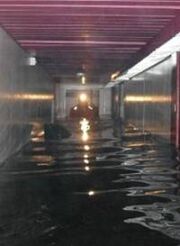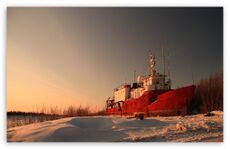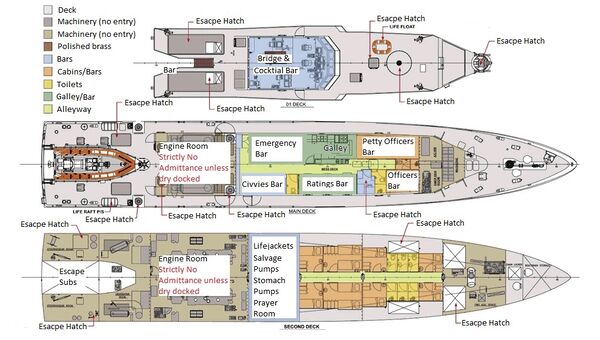Boaty McBoatface
The RRS Boaty McBoatface is a new merchant navy ice-breaking research vessel of the United Kingdom, crewed by the Royal Navy. The new vessel's role is to conduct scientific research for Her Majesty's Government. Organisations involved in operations include: the Natural Environment Research Council (NERC), the British Antarctic Survey (BAS), the National Oceanography Centre (NOC), some salvage tugs (HELP) and a Chilean search and rescue helicopter (999/911/SOS). A warrant from the Queen is required before a ship can be designated as an RRS rather than an HMS (Her Majesty's Ship), which on this occasion met little resistance.
Boaty McBoatface is the replacement for HMS Endurance, a vessel famous for being the first ship to be sunk by the Royal Navy since the ARA General Belgrano during the Falklands War thirty years previously. Since then, the Navy have only sunk two vessels on operational deployments, HMS Nottingham and HMS Grimsby, remaining true to the recent form of sinking their own vessels, rather than the enemy's.
In the 1950s and 1960s the Royal Research Ships of the day were owned by the Admiralty, partially managed by the merchant-ship trained Royal Fleet Auxiliary (RFA), and run as ships of that fleet. In recent times, the Royal Navy has been blessed with more Admirals than ships, many of whom are focused on offering a good deal on your car insurance. However, to keep fleet numbers up and maintain the facade of a 'Superpower' the Navy’s finest war-fighters have been appointed to crew sophisticated, unarmed ice-breaking research vessels; but only after a three day ‘death by Power Point’ merchant ship familiarisation course at HMS Rupert.
History
On the 25 April 2014 it was announced by the Chancellor of the Exchequer, George Osborne, that £200 million would be invested in the construction of a new polar research ship, to replace RRS Ernest Shackleton and RRS James Clark Ross, brushing over the fact that both vessels were chartered prior to the ignominy of HMS Endurance’s accidental scuppering — for all to see — during the filming of a National Geographic documentary on board the vessel.
In October 2015 it was announced that the Boaty McBoatface will be built by the Cammell Laird shipyard in Birkenhead, with construction expected to start in Autumn 2016. The new icebreaker will be designed with a helipad, on-board laboratory , extra lifeboats and the capability to deploy emergency escape submarines. The vessel is expected to enter service in 2019 on the proviso the Royal Navy promises not to sink this one.
As the vessel was owned by the Crown, therefore the British general public, an online poll was opened to allow the British people to vote on the vessel's name. Recalling the entertaining performance of HMS Endurance's crew's endeavors, the public voted unanimously on naming the vessel HMS Boaty McBoatface. However, the Admiralty did not think the name was 'warry' enough to be an HMS, so opted to apply to Her Majesty to name her RRS Boaty McBoatface.
Design
From cutting the first steel to launching a smallish ice-breaker, normally takes around a year. However, to make sure the vessel meets the requirements of Royal Navy operating procedures (sink proof) — and allow time for all three hundred senior members of the MOD Procurement Department to change the layout mid-build as employment justification — Osbourne has allowed three years. The stratospheric cost of the vessel also takes into account the above criteria.
One of the key differences between a warship and a commercial ship (apart from the somewhat drab colour scheme and big guns) is the latter is more easily scuttled, as the hull has many very big holes for taking on thousands of tons of water ballast or cooling very large machinery. Additionally, a modern warship’s crew are highly trained in preventing a ship sinking when holed, but not trained in preventing holes in their ship. That particular course was replaced in lieu of the year-long ‘Minimum Standards of Officer Etiquette While Executing a Cocktail Party for the Governor of Bermuda’. Regular warship hull design takes into consideration this vital segment of a young officer’s training, from the bottoms-up.
Design concepts
Several concepts were discussed, including making passage while piggy-backed on a semi-submersible barge, giving the vessel legs so it can lift the hull clear of the water before anyone is permitted to enter the engine room, or constructing the vessel on land, taking the incompatibilities associated with water and machinery out of the equation altogether. These ideas, while perfectly adequate for Boaty McBoatface’s role in defence of the realm, did not sit well with seaman officers.
Today, the Royal Navy career path mainly involves the navigation of desks throughout the UK and allied countries based in the tropics; charting a safe passage of anything from stationary control to golf course bookings. With the ongoing government cuts to numbers, many roles at sea are being filled by Naval Reservists who are, in the main, Public Relations consultants or bank managers, when they weren’t playing Battleships twice a year.
For this particular cadre of semi-submersible seaman, a ship high-and-dry would probably be for the best regarding everyone concerned. However, keen young navigators straight out of Dartmouth Naval College, could see themselves missing out on the once-a-career opportunity to wear a set of binoculars around their necks, and bark helm orders at grizzled ‘bottle-of-scotch-a-day’ quartermasters from Stornoway. Much as counting bullets, or doing an efficient job as bar stockist in the wardroom of one of Her Majesty’s warships gives ‘Subbies’ a sense of national pride, it is the bridge and ops room where the action really takes place.
Senior personnel from the Ministry of Defence agreed. Although building the next ice patrol ship on dry land was still less embarrassing than sinking it on prime-time television, approval for an operational floating platform was granted by George Osbourne; provided the naval architects and operational planners conformed to the following requirements:
- There is no cabin allocation for television crews.
- There are no doors, valves or any other ways a PT instructor with a short maintenance course, and even shorter attention span, could expose the machinery spaces to catastrophically rapid water ingress.
- Spacecraft levels of redundancy are built into the design, removing the requirement for entry into the machinery spaces altogether, unless armed with a mop and bucket.
- Infinite loop safety management checklists, to forestall any funny ideas about doing a bit of tweaking.
- Restrict the operating depth to no more than one metre of under keel clearance from the sea bed, so in the unfortunate event of accidently sinking, no one external to the vessel would notice.
- Space for a dozen portable salvage pumps.
- Floatex carpets.
- In response to the Royal Navy's request to have plenty of brass fittings to polish, fill your boots.
Conforming to the above requirements, the design of RRS Boaty McBoatface will mark a huge advance in the safety elements of ‘Naval Support’. Her operational effectiveness in the Arctic and Antarctic as a military ‘show of force’ to resident penguins and elephant seals is maintained, and even to some extent unhindered by sinking in the unlikely event that would occur a fourth time.
Construction and general arrangement
Ship design for operations in the cold and barren high latitudes of the southern hemisphere requires careful consideration, internally as well as externally. Research in the region is somewhat hampered by vast areas of nothing requiring researching, as the properties of sea and ice are relatively well known. The chance of spotting an extremely rare bird, such as a stone curlew, in a barren moorland, is about the same frequency as spotting anything at all in the South Atlantic. Another issue is the length of a day, which is on average 4320 hours, followed by 4440 hours of night.
The majority of the working day on Boaty McBoatface will be spent looking for anything that is not water based, a few hundred port visits and a crew change or two. Overnight, the only thing to do to prevent acute cabin fever is to get pissed. Boaty McBoatface has been specifically designed to handle such requirements, having a cocktail bar, as well as bar for the scientists and researchers. It also has special facilities to cover the requirements of the Royal Navy, in so far as Her Majesty's regulations forbid fraternization between officers, petty officers and the ranks; so they have a bar each too. In order to maintain redundancy in an area where there is nothing, the ship also has an emergency bar.
Another consideration is sinking the ship in an area where rescue is unlikely until the morning, which is usually late April or early May depending on latitude. One innovative safety feature of Boaty McBoatface is that all the machinery spaces will be welded shut at the shipyard where she is being built. Should any machinery fail, there are sufficient stocks of pink gin and Pimms to get the crew through to sunrise and an emergency tow can then be arranged to the Falkland Islands, where they have welding equipment.
Other roles
Boaty McBoatface will be fitted with multibeam echosounders, so the crew have a facility to keep themselves calm and psychologically on an 'even keel' by looking at fish, which is considered therapeutic. In addition, she will be able to tow an L3/Klein System 5000 sidescan sonar, which is the perfect size to house eight bottles of Frascati, keeping it ice cool for the Saturday seafood buffet. Her launches can be equipped with additional hull-mounted general purpose machine guns, in case the buffet needs a top up. Additionally, Boaty McBoatface's personnel can establish horizontal and vertical control instruments, such as Global Positioning System (GPS) base stations and tide-level measuring devices, in the remote areas in which the ship works. Using this technology, the crew can return to the vessel safely, just in case they are caught in a white-out while on a glacier collecting ice for gin and tonics.
Despite her limited military capability, Boaty McBoatface is still a Royal Navy vessel, with a commissioned crew with powers of interrogation and arrest in international waters. She has a requirement to defend the interests of the United Kingdom, just in case an offensive is launched against the country from Antarctica. She will be an official representative of the United Kingdom's task force at the very frontiers of life on earth, and the all-day (and night) full-English breakfast will be to die for.
See also:
| Featured version: 14 May 2016 | |
| This article has been featured on the main page. — You can vote for or nominate your favourite articles at Uncyclopedia:VFH. | |






